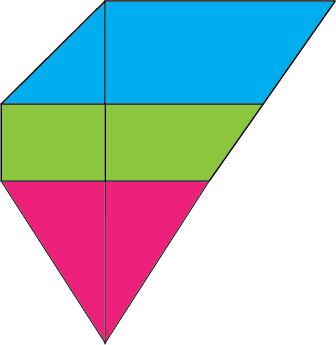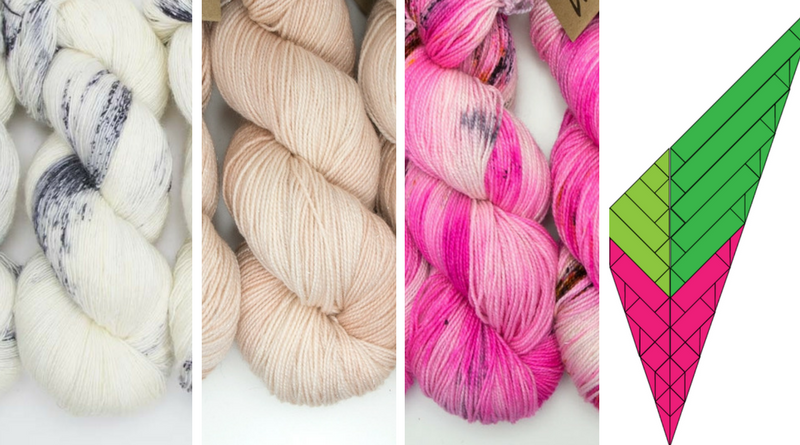The Secrets of Kite Shawls
Back in 2017 I published my first article about kite shawls and their construction. Since then, I designed a few and thought thoroughly about how to explain the design principles of kite shawls better and make it easier to understand. I realised that my original thoughts about its construction principles was not the full picture. There’s always room for improvement, so here comes my updated post about the secrets of kite shawls.
Kite shawls are triangle shawls with a biased line of knitting. The most famous example of such a shawl is the Find Your Fade shawl by Andrea Mowry.
The Three Sections of Every Kite Shawl
Every kite shawls consists of three sections:
- An increase section (shown in pink in the pictures illustrating this article),
- a section worked straight (green), and
- a decrease section (blue).
The final shape is achieved by blocking, but more on this later. Let’s have a look at each section first.

All three sections consist of triangles and rectangles as basic shapes.
The Increase Section
The first section of a kite shawl is symmetrical. It starts with a few stitches and proceeds with two increases every row together with a central double decrease in the center of each right side row, resulting in a total of two stitches increased every other row or one stitch every other row if looking at one side (left or right) only.
This increase rate is equal to a triangle shawl worked sideways (if looking at one half only) or a triangle shawl worked bottom up if looking at the whole triangle. The trick is, and that’s why the increase section looks more like an arrow, the additional increases (on the outsides) and decreases (the cdd in the center). These additional stitches, not being part of the triangle construction themselves, changes the shape totally.
The Straight Section
The increase section is followed by a straight section where shape effective increases are worked only on the right half. On the left half, only the additional stitches are worked as before (increase on the edge, decrease at the center).
The Decrease Section
After the straight part we continue to the decrease section: The right half is worked similar to the straight section, on the left half the increase stitches at the edge are no longer worked. This results in a decreasing stitch count on the left half of the shawl. This is continued until no stitches are left after the central double decrease.
Summary
It looks like a complicated little shawl, that’s for sure. But the truth is, it’s actually quite simple once you get a grip of it. When you put it all together it looks like the picture below.

The second part of this article teaches you how to calculate yardage for each section – we don’t want to run out of yarn knitting kite shawls after all, do we? I mean, not like me the first two times I tried (the third time I ended up with a shawl big enough to cover a whole herd of sheep, but that’s another story).
Continue reading part two here: The Fade Mathematics: Kite Shawl Calulations.


Hello Julia,
Im from Holland and knitting you’re beautiful kite shawl, I’m half way there, and I love it. I can’t stop, I work with beautiful colors ( orange, dark orange, yellow, red, and the main color is turquoise), it’s a pity that we can’t. Share pictures.
Thank you so much for this beautiful pattern
Greats from Holland
Helma
Pingback: Shawl Design for Everybody - Your Free Shawl Design Online Course
Thank you for sharing your knowledge and experience. You are not only a gifted knitter and teacher but a generous spirit and kind. In short, a wonderful person! Thanks so much!
My pleasure 🙂
Pingback: The Secrets of Kite Shawls (Original 2017 Post) - knitting.today
You know, I think this is an awesome tutorial! I absolutely understood what you are saying. Well put! Thank you so much for the effort in making all those charts! Stay well, Rocío
My pleasure!
Dr,Julia I am knitting teacher and I like Kite shawlI will knit in my doctors waiting room.now I am knitting blankets for my greatgrand children ……….stay well….Berta Kogan
Pingback: The Fade Mathematics: Kite Shawl Calculations - knitting.today